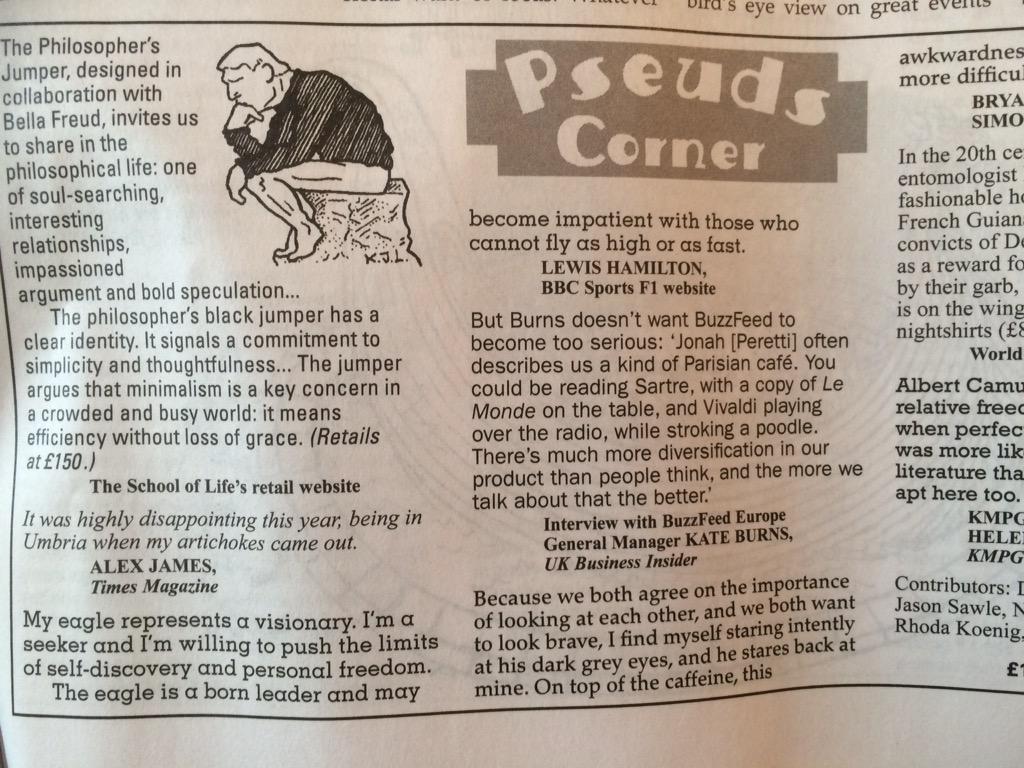
The English satirical magazine Private Eye has long published a column named Pseuds Corner where pretentious nonsense is reprinted in all its glory. For example:
“The sheer courage of these pieces is breathtaking. The space inside, the gap between the walls, narrows, widens, breathes in and out (if you can speak of massive iron “breathing”, which in Serra’s work you can) and eventually rewards you with an inner chamber, from which you have to follow the same route out each emphasizes the ancient Greek philosopher’s Zen-like adage: hodos ano kato mia kai hote, “the way up and the way down are one and the same.” A maze would be fussy; it would interfere with the stupendous directness and logic of Serra’s spatial language. Robert Hughes on the Richard Serra installation at the Bilbao Guggenheim.
Phew!
Well, I never cease to be amused by the vast volume of Pseuds’ Corner prose that the world of photography attracts. Here are some recent examples – the names of the authors and publications have been suppressed to protect the pretentious.
“After a small quantity of test rolls (about 25 in all), both my regular Tri-X, some Lucky 400 made in China and Fuji Acros my personal feeling is: If you already have a later version of the Summicron 50 (and who doesn’t) or a clean 50DR Summicron you would not see much difference on your negatives (from pictures taken with the lens under review).”
From a a self-proclaimed Leica “expert” whose claim to fame seems to be ownership of dozens, if not hundreds of lenses for his Leicas (such fame is certainly not based on the quality of his photographic output).
“As W became better known, he was forced to try to explain in words matters that he knew could not be explained at all, but that might with luck be demonstrated in pictures.”
From the introduction to a book of photographs of a vastly overrated machine gun shooter whose demise caused many a moist eye in the accounting department at Kodak.
“Dualities have always been a feature in M’s life and work. He speaks of a “dark Manichaean flavor” in his earlier urban subjects, but that is not an element in his landscape work.”
From the notes to a book of M’s landscape photographs which prove without a shadow of a doubt that he should have stuck to street shooting.
“E’s affection for photography began at the time when he was starting a new life of sobriety. It is almost as if photography, with its directness, truth, and poignancy, became symbolic of this new life.”
From the introduction to a book about a manic collector of seemingly every famous photograph under the sun.
“Michael works in a special place; on the edge of darkness and light. His images hold a mirror to each viewer’s soul and conscience.”
From the introduction to a book of photographs by a darling of the collector set who has basically taken the same photograph a thousand times over the past twenty years.
“For his simplicity and his unbridled passion for his art, for all that has gone before and for all kinds of other reasons, a lot of which have nothing to do with photography, but a lot to do with art, and for never knowing when to stop chasing rainbows, B is a hero to his own generation and beyond.”
Introduction to a book of photographs by a famous fashion photographer.
“Technical fetishism also has its theoretical counterpart, namely the art of photographing.”
Introduction to a book of one of the most famous street photographers.
* * * * *
I didn’t make these up. Honest. I just went to the largest photography books in my library. The larger the format of the book the more of this sort of clap-trap is to be found in its pages. That does not mean you should stop buying large format books, only that you should look at the pictures and disregard the turgid prose. And remember – no Pseud ever took a good picture.